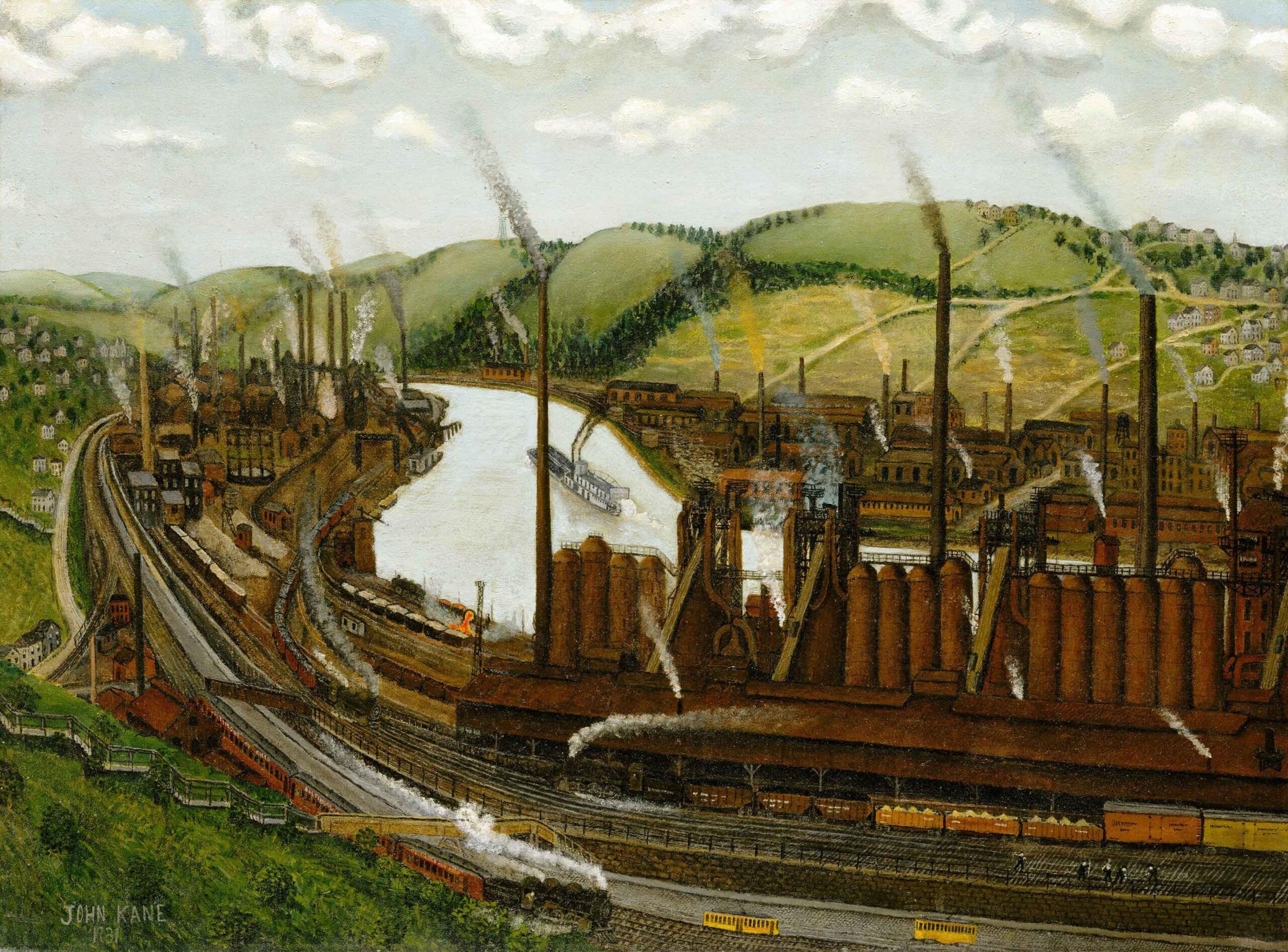
In his painting The Monongahela River Valley, Pennsylvania, the Scottish-born, self-taught John Kane offers an ode to the ever-growing industrialization in his adopted hometown of Pittsburgh. Painted in 1931, and now part of the collection at The Met, the landscape that Kane captured borders on pastoral. In the foreground, white fog tumbles from smokestacks set against perfect blue skies, while copper-hued factories rise from the banks on either side of the river as if extensions of the soil itself. Above, cotton-white clouds hang in the valley like decorative adornments, and lush green hills dotted with small houses and trees vanish into the endless horizon. Still, something is amiss.
In Kane’s painting the scene is picturesque, perhaps too much so. It offers an idealized rendering of industry’s invasive footprint on the land, where there is somehow harmony between man-made blast furnaces and the natural world. Where red-hot crucibles cast iron into steel, and where progress is defined by what can be harvested from the environment and sold. Some might even call Kane’s painting propagandist. There are no plumes of black smoke blotting out the sun, a scene captured time and again on Pittsburgh streets throughout the first half of the 20th century. And the waters of the Monongahela River shimmer blue in the daylight, no signs of soot or carbon darkening its depths or shores.
To be fair, the Pittsburgh that Kane inhabited was far different than what the city has become. As a lifelong laborer who wasn’t discovered as an artist until he was 67, he painted the Monongahela River Valley at a time when it was producing half of the nation’s steel.1 It was the Silicon Valley of the industrial age. The steel shipped out of Pittsburgh was used to build skyscrapers, automobiles, and to strengthen America’s war machine. As far as Kane knew, there was no end in sight. But that’s only because he didn’t live long enough to witness the collapse.
Today, nearly 100 years since Kane painted the Monongahela River Valley as a place of American ingenuity and promise, the landscape is littered with the skeletal remains of an industry that once seemed unstoppable. Perhaps it’s fitting that the valley and river derive their names from the Lenape word Mënaonkihëla, which means “where banks cave in or erode.”2 That natural erosion of soil and rock has been mirrored in the economic collapse of industries throughout the valley. In towns from Monessen and Rankin to Braddock, Duquesne, and Clairton, residents are in the midst of a decades-long postindustrial depression that shows no signs of letting up. These towns are outliers that reaped little benefit from Pittsburgh’s transformation to a hub of medical research and higher education in the 1980s and 1990s. And they exist at a remove from the city’s current economic renaissance, where neighborhoods like Lawrenceville and East Liberty are being remade into increasingly affluent hipster enclaves as tech giants like Amazon, Google, Uber, and Intel have set up headquarters in the city.3
The photographs in this essay are selections from Searching for Dream Street, photographer Pete Marovich’s project documenting the state of old steel towns along the Allegheny, Monongahela, and Ohio rivers within approximately 40 miles of Pittsburgh, Pennsylvania.
Nowhere in recent memory are the present-day realities in the Monongahela River Valley better documented than in photographer Pete Marovich’s Searching for Dream Street project, which offers an unvarnished look at the socioeconomic status of the old steel towns along the Allegheny, Ohio, and Monongahela rivers. Marovich, an award-winning photojournalist and contributor to Bloomberg, The Washington Post, The Washington Times, Getty Images, and NBC News, has visited dozens of towns in and around Pittsburgh over the last several years to gain an intimate understanding of what life after industry both looks and feels like. Inspired by photographer W. Eugene Smith’s extensive documentation of Pittsburgh in the mid-1950s, which was later chronicled in the book Dream Street, Marovich’s photographs of the Monongahela River Valley capture everyday moments in these working-class towns long after the smoke has lifted.
“As you drive through these towns today, it’s clear they have been largely forgotten,” Marovich writes in his statement about the project. “Once-bustling shopping corridors are all but empty. The company homes where mill workers raised their families are showing their age, and residents still reminisce about the ‘good old days’—before the mills were shuttered.”

The towns that Marovich chose to document all share one cruel but unshakeable truth: they have outlasted their original purpose. Save for Braddock and Clairton, where the Edgar Thompson Steel Works and Clairton Coke Works still operate (the former at reduced capacity), no other Mon Valley towns even have functional steel mills today. When the work disappeared and the local economies faltered, a host of new problems emerged—from unemployment, poverty, blight, and population loss to violence, crime, and addiction.
Today, even as Pittsburgh is touted as a model city for tech and innovation, poverty remains a persistent problem. In the Pittsburgh area, which is located in Allegheny County, 61 percent of people who live in poverty live outside the urban core. Additionally, 79 percent of poverty in the seven-county Pittsburgh metropolitan statistical area exists outside the Pittsburgh city limits. These statistics, cited in a 2016 University of Pittsburgh Institute of Politics report titled “Poverty: Beyond the Urban Core,” reflect a trend of increasing concern. Namely, a growing economic divide between affluent and low-income residents in the Greater Pittsburgh Area. Which is to say, the majority of Pittsburghers are not necessarily benefitting from the city’s growing reputation as a tech hub with world-class restaurants and a thriving cultural scene. When you look at statistics for the Monongahela River Valley in particular, and break down the poverty rates on a town-by-town basis, the numbers are even more alarming: Braddock (40%), Clairton (29%), Duquesne (38%), Monessen (21%), and Rankin (44%). Pair that with median annual household incomes and you get a better sense of the economic plight that residents face: Braddock ($22,000), Clairton ($27,000), Duquesne ($20,000), Monessen ($31,000), and Rankin ($20,000).4

While these former mill towns are not traditionally viewed as suburban, each is faced with similar challenges to the first-ring suburbs across the country where poverty has taken root over the last decade and a half. Chief among these challenges are access to safe schools, public transit, pedestrian-friendly streets, and grocery stores. Alexandra Murphy, author of the forthcoming book When the Sidewalks End: Poverty in an American Suburb and researcher for the University of Michigan’s Population Studies Center at the Institute for Social Research—who spent a year studying poverty in nearby Penn Hills—has noted in the past why this growing problem goes unnoticed: “[Suburban poverty] is relatively invisible to the casual observer or resident who commutes through town on main roads. Housing and where the poor live is distinctly zoned away from commercial areas.”5
In Pittsburgh, with its unique topography of hills, valleys, and hollows, this is particularly true. Moving from neighborhood to neighborhood, let alone town to town, can often feel like transitioning between worlds. Often that shift is distinguishable. You see the design of the street signs change from neighborhood to neighborhood, or the condition of the sidewalks and pavement improves or degrades from borough to borough. But the further east you travel from Pittsburgh’s urban core, as you enter the Monongahela River Valley, the more isolated and foreign a place like Duquesne appears—where heroin use is on the rise, the economy is all but gone, storefronts are shuttered, and children are bussed to districts where the schools haven’t yet closed. And the same can be said about a town like Clairton, where the massive Clairton Coke Works spews clouds of particulate matter that can irritate the eyes and even leave an unpleasant taste in the mouth. If the high school football team, the Clairton Bears, wasn’t so perennially successful, it’s quite possible the town might become as invisible to outsiders as the problems its residents face.
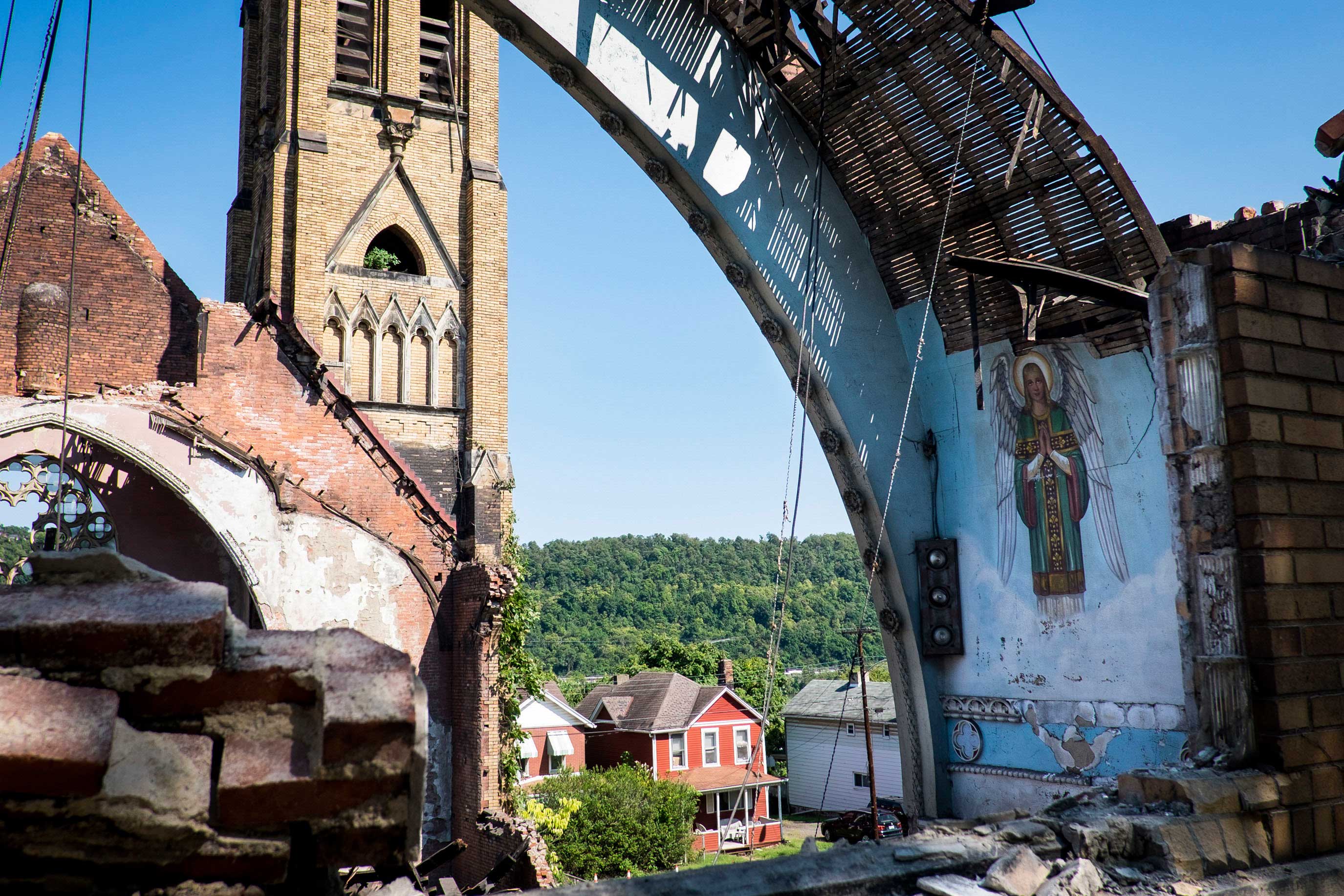

When you look at Marovich’s photographs, the first thing you notice is how aptly he has captured the spirit of the Monongahela River Valley. His portraits and landscapes, which are at once somber, honest, and hopeful, depict life in the valley as it is today. Whether it’s his portrait of 63-year-old Donald “Amzi” Lightner playing music in the living room of his Clairton home, or the image of Navy veteran George McAllister taking a break as he leans against the bed of his pick-up truck after clearing rubble from the lot where his house recently burned down in Rankin. There’s a sense that, while the people he has met along the way are each complicated and individualistic, they are not as defined by economic hardship as the stereotypes we tend to conjure in our minds. It’s evident that Marovich has approached his documentation of each town and its citizens with reverence. And not just simply in asking their permission to be photographed—but in getting to know them and their stories through conversations and time spent. Marovich’s images seem to exist at the intersection of past and present, intimately addressing the void between prosperity and obsolescence. And while his photographs offer an example of thoughtful representation, they also bring to mind larger questions of journalistic representation in the region.

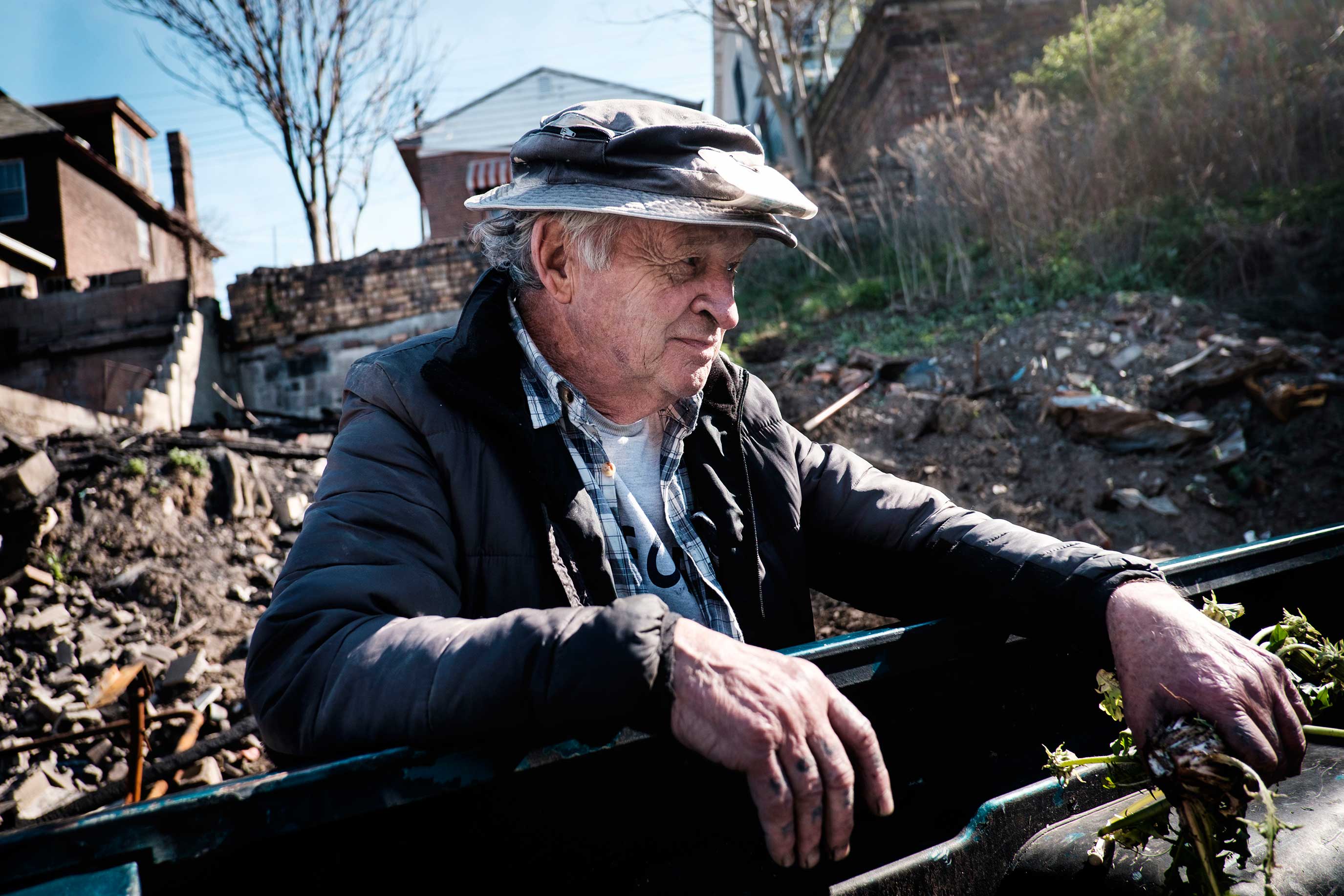
Over the last decade, for example, countless reporters and photojournalists have converged on the Mon Valley—primarily due to the revitalization efforts of Mayor John Fetterman in Braddock, whose work has attracted considerable local, national, and international media attention. Yet the tenor and tone of these depictions have varied.6 Many typified what is referred to as “parachute journalism,” or the practice of thrusting a journalist into an area to report on a story in which he or she has little knowledge or experience. In those cases, much attention has been paid to vacant landscapes and industrial wreckage, with few cameras pointed at teenagers playing basketball on neighborhood courts, children gathered at local libraries, or corner bodegas bustling with activity. Pittsburgh’s own burden of identity, one forever entwined with the boom and bust of the steel industry, often preempts an outsider’s ability to tell a story unmarred by stereotypes. That’s why we often see a close-cropped portrait of a former steelworker, or a wide shot of an unemployment center, or a rain-soaked image of a singular blighted home. It’s stock imagery used as a generic stand-in for socioeconomic distress—a way to reinforce preconceived notions that do nothing but discourage nuanced discussion or understanding.7

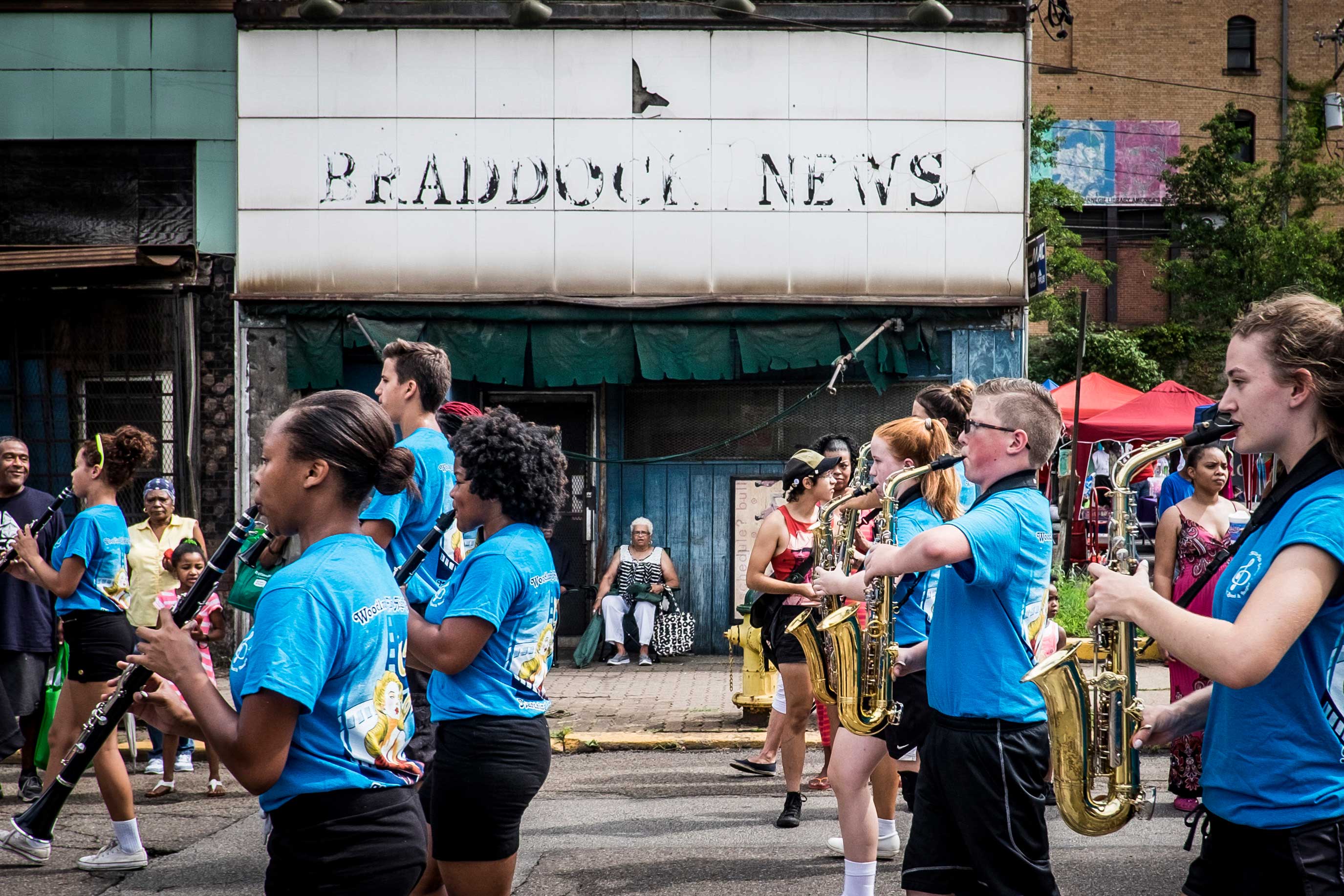
Photographs taken in the Monongahela River Valley, particularly those that fall into the “ruin porn” canon, often omit the lives still being lived while fetishizing hardship and despair. Even thoughtful, well-reported portrayals of the Mon Valley rely on the specter of Big Steel to espouse the ill effects of globalization—which often reduces these towns and their residents to little more than collateral damage. And it’s not a practice unique to Pittsburgh or its many former mill towns. It’s a problem all of Appalachia has faced ever since President Lyndon B. Johnson first declared his War on Poverty back in 1964—an initiative that focused the lens of the national media squarely on America’s poor. Today that practice still persists, which became increasingly evident during last year’s contentious presidential campaign, when news imagery and campaign rhetoric aimed at the working class almost exclusively centered on issues of identity.8 But there is also a new generation of documentariansintent on crafting more representative images of the region.
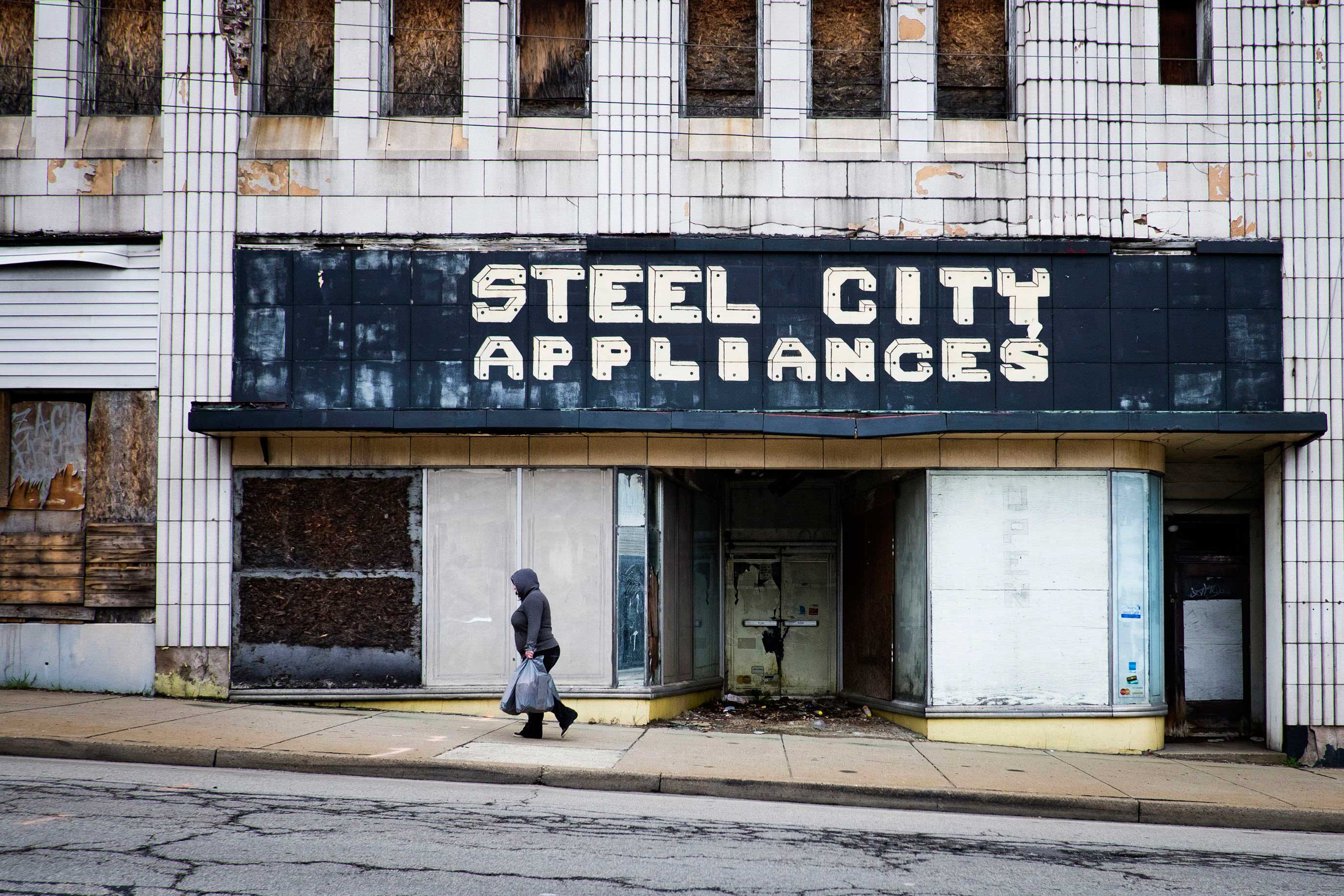

It’s worth noting that John Kane was not the only artist influenced by the industrialization of the Monongahela River Valley. In fact, he was just one of many to recognize the significance of the particular moment he was living through—someone who felt the spiritual and political pull of history. Aaron Gorson, whose painting Pittsburgh at Night depicts glowing blast furnaces along the river, was captivated by the city’s inertia during the first part of the 20th century. Years later, the poet Robert Gibb, a Homestead native, drew on Gorson’s painting for his poem titled “Industrial Landscapes,” which lyrically expands on the scene:
In Pittsburgh at Night, for instance, white smoke
And the acetylene flash of metals being tapped,
The Bessemer conversion of cast iron into steel,
Are arrayed against the beryl of river and sky,
The silhouetted colonnades of the chimneys.
I stood before those familiar waters whole hours,
Growing up, at the picture plane of the foreground
On which the dark, cropped barges float.
Those familiar waters influenced others to create. In Braddock, for example, where the Mon washes against the muddy shores beside the towering Edgar Thompson Steel Works—Andrew Carnegie’s first steel mill—many artists have offered differing interpretations of industrialized life. Not to mention its varying impacts.
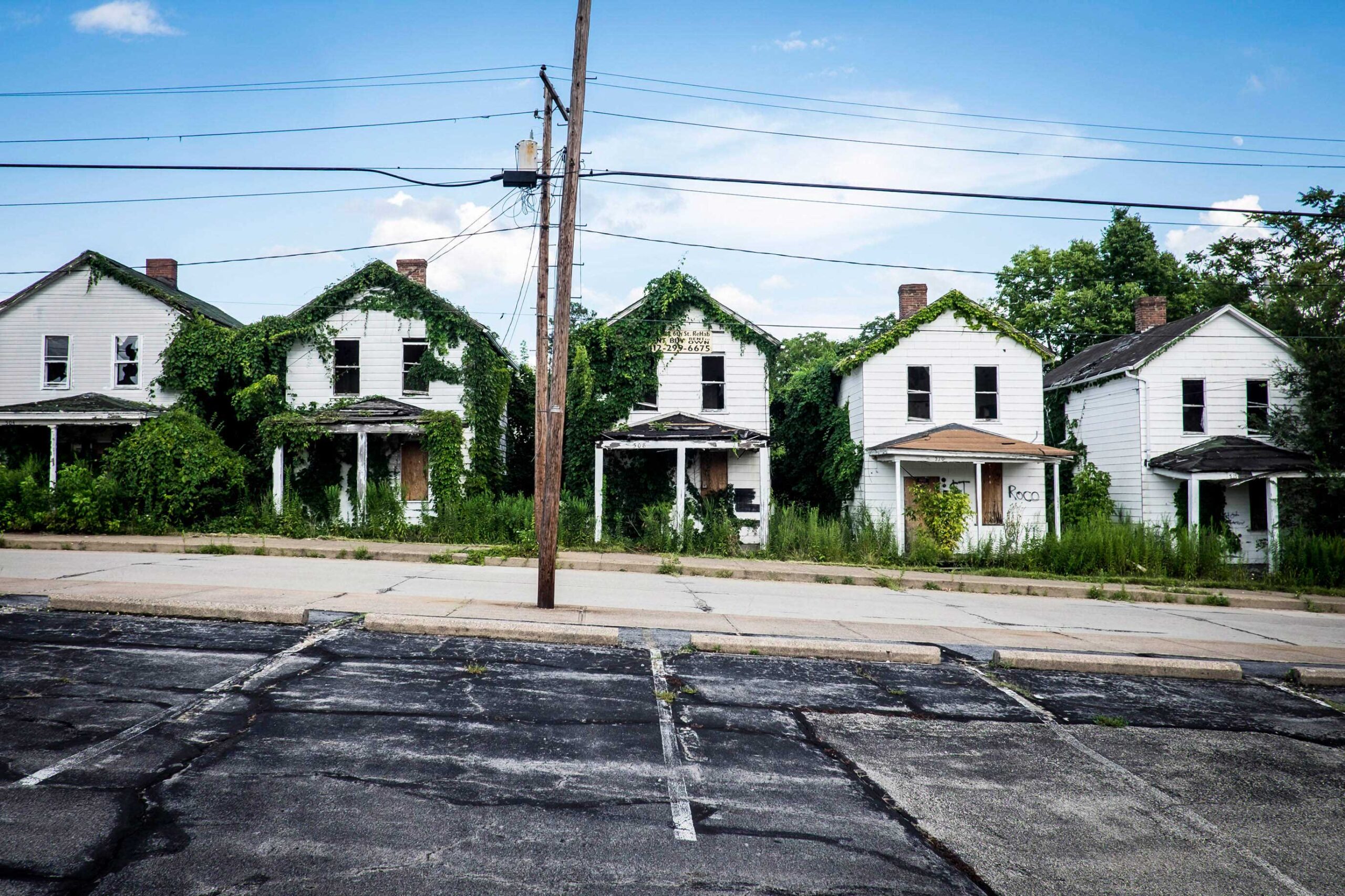
Thomas Bell, author of the novel Out of This Furnace, penned a fictionalized account of a Slovakian family emigrating to America to work in the steel mills of the Mon Valley. Set in Braddock starting in the late 1800s, the book follows three generations of the Kracha family, foregrounding the tragedy of historical events like the Homestead Strike of 1892 while also dealing with issues of family, labor, unionization, poverty, and discrimination.
In many ways documentary filmmaker Tony Buba, who has spent more than four decades chronicling his hometown of Braddock, picked up where Thomas Bell left off—documenting the dissolution of the working class after the boom years of the early 20th century. His films, black-and-white 16mm shorts such as J. Roy’s New and Used Furniture (1974), Betty’s Corner Café (1976), Sweet Sal (1979), and Mill Hunk Herald (1981) each capture, in their own darkly comical voice, the tender humanity of what it means to live in a place experiencing dramatic transition. Of all Buba’s films, Lightning Over Braddock (1988), his meta critique on the concept of capitalizing on the documentation of his hometown’s demise, is the filmmaker’s magnum opus. It turns the camera back on himself in a thoughtful and hilarious examination of motive and intent. And like so much art that has come out of the valley, the idea of representation—and who establishes and controls that narrative—is a galvanizing theme.

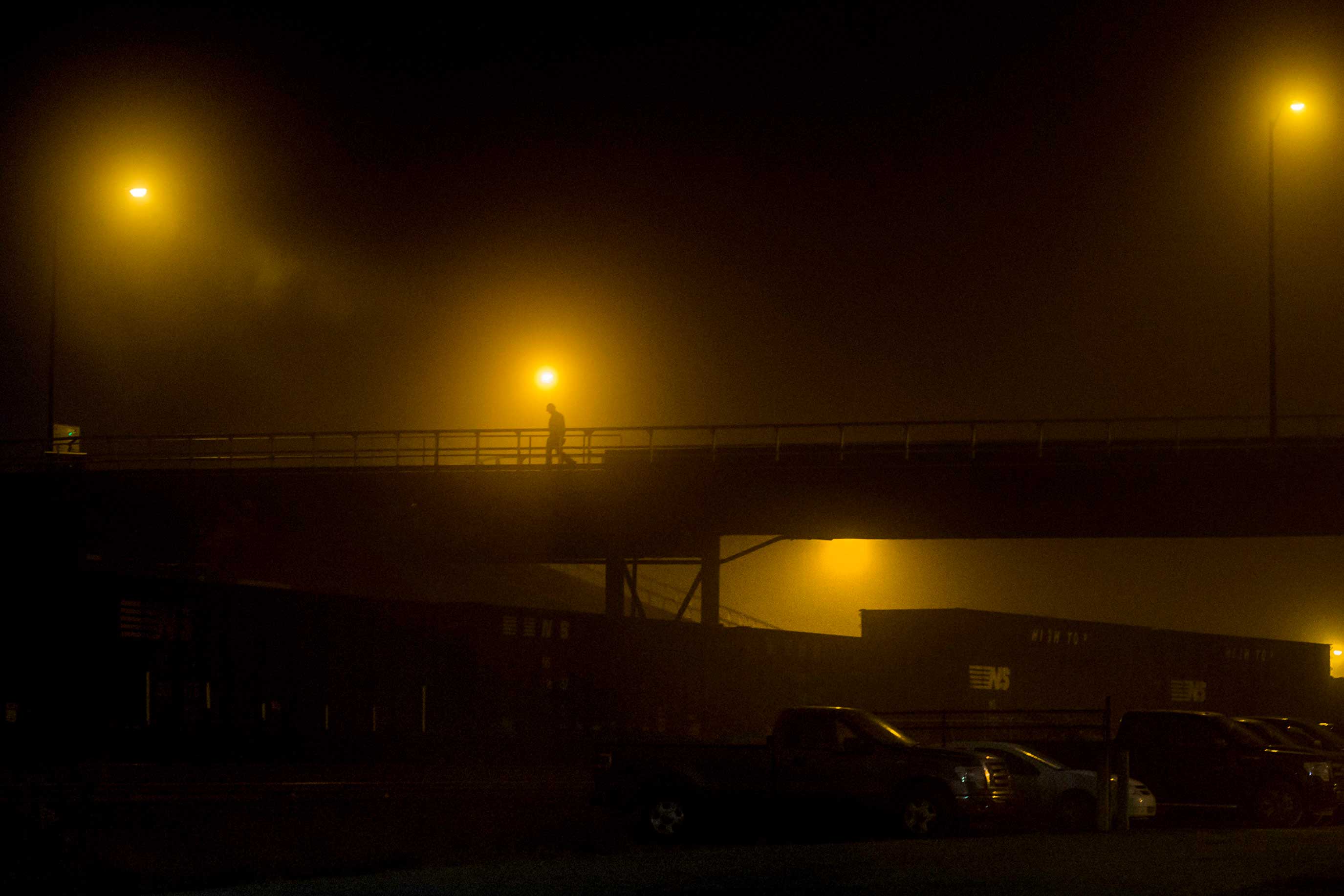
In recent years, however, no artist has addressed issues of dispossession and the effects of industry in the Mon Valley quite like Braddock native and photographer LaToya Ruby Frazier, who in 2015 won a MacArthur “genius” grant for her work. In The Notion of Family, her book documenting the economic decline of Braddock and the failure of its local healthcare system, Frazier deftly chronicles the highs and lows of life in Braddock through the eyes of her family:
Grandma Ruby, Mom, and I grew up in significantly different economic climates; each of us are markers along a larger historical timeline. Grandma Ruby, born in 1925, witnessed Braddock’s prosperous days of department stores, theaters, and restaurants. Mom, born in 1959, witnessed the close of the steel mills, white flight, and disinvestment at the federal, state, and local levels. I was born in 1982. I witnessed as the War on Drugs decimated my family and community.
By establishing this generational divide and familial arc early in the book, Frazier foregrounds the march of time and the inevitability of socioeconomic circumstances as persistent themes. And while she is acting as both family historian and eyewitness to history in her capacity as an artist, there is a sense that both roles are as inescapable as the long shadow of the Monongahela River Valley.

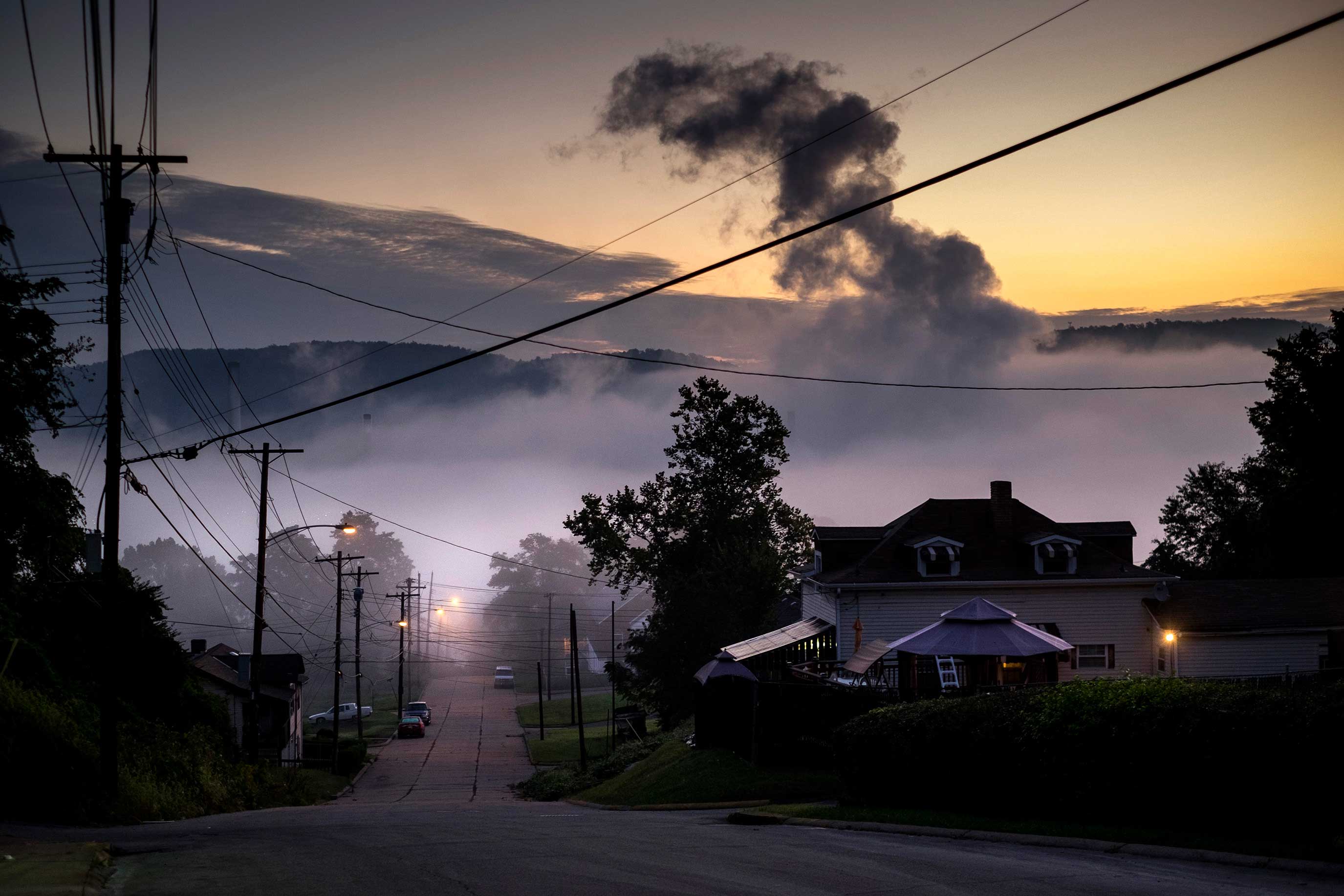
Family, it turns out, is a powerful undercurrent. It’s what first prompted Marovich to head to Pittsburgh with his camera, arriving in Aliquippa, the Ohio River Valley town where his mother and father were born and raised. It’s also the town where his father and grandfather had both worked in the Jones and Laughlin steel mill. “The immigrants who settled in Aliquippa came with dreams of a better life,” Marovich writes. “But many of the people living there today doubt that those dreams still exist.” Like John Kane and Aaron Gorson before him, Marovich too felt the pull of history—a desire to document this sequence of dreams in the forgotten river valleys that surround Pittsburgh, whether realized or not.
Matthew Newton is director of publishing at The Andy Warhol Museum, where he oversees all editorial, design, photographic, and digital content for the museum, including exhibitions, books, and special projects. Prior to joining The Warhol, he was director of publishing at Carnegie Museum of Art, where he also founded Storyboard, the institution’s award-winning online arts journal. He has written essays, many about class and culture, for Guernica, The Oxford American, and The Rumpus, and his reporting has appeared in The Atlantic’s CityLab, Esquire, Forbes, and Spin. He has been awarded grants and fellowships from Creative Capital, Staunton Farm Foundation, Creative Nonfiction, Greater Pittsburgh Arts Council, and Pittsburgh Center for the Arts. His debut nonfiction book, Shopping Mall, was published by Bloomsbury in September 2017.
Envisioning Appalachia was an ongoing series that explored concepts of place, identity, and economic transition in the region’s urban and rural areas. The series was produced in partnership with the Appalachian Media Institute at Appalshop.
The images in this essay are selections from Searching for Dream Street, photographer Pete Marovich’s project documenting the state of old steel towns along the Allegheny, Monongahela, and Ohio rivers within approximately 40 miles of Pittsburgh, Pennsylvania.
This essay is a finalist for a 2018 Golden Quill Award recognizing excellence in regional journalism.
Storyboard was the award-winning online journal and forum for critical thinking and provocative conversations at Carnegie Museum of Art. From 2014 to 2021, Storyboard published articles, photo essays, interviews, and more, that spoke to a local, national, and international arts readership.